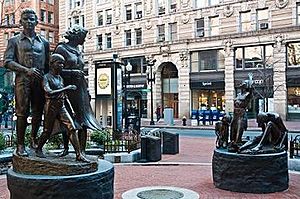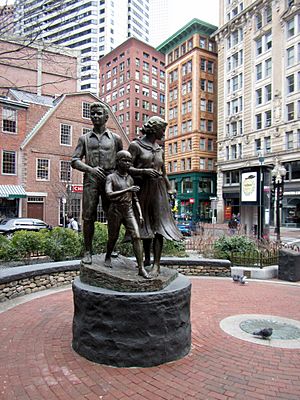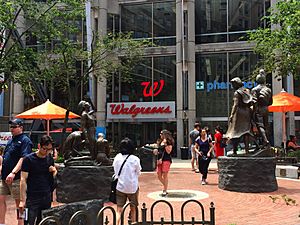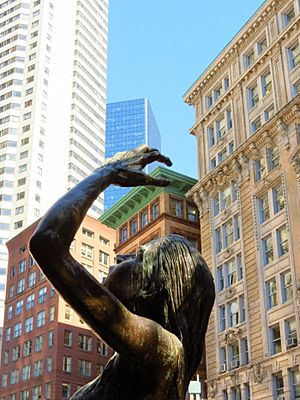Boston Irish Famine Memorial facts for kids
Quick facts for kids Boston Irish Famine Memorial |
|
|---|---|

Memorial as seen from the front
|
|
| Type | Memorial Park |
| Location | Between Washington Street and School Street |
| Nearest city | Boston, Massachusetts |
| Created | 1998 |
| Visitors | 3 million visitors each year. |
The Boston Irish Famine Memorial is a special park in Boston, Massachusetts. It sits between Washington Street and School Street. This park remembers a sad time in history called the Great Famine. This famine happened in Ireland from 1845 to 1852.
The memorial has two groups of statues. One group shows an Irish family suffering during the famine. The other group shows a family that moved to America and found success. This shows the journey from hardship to hope. A businessman named Thomas Flatley helped pay for the park. It opened in 1998. Many people visit this memorial each year.
Contents
How the Memorial Was Made
The land for the memorial park was given to the memorial group in 1998. This was done by the Boston Redevelopment Authority, which is part of the city government. The project cost about $1 million.
A successful Irish-American businessman named Thomas Flatley led the effort. Many people from Boston's Irish-American community also helped. They wanted to create a place to remember the famine and the journey of Irish immigrants.
What the Memorial Looks Like
The main part of the park is its statues. These statues were made by an artist named Robert Shure. There are two groups of statues. One group shows a family that is thin and wearing torn clothes. They represent the suffering during the famine. The other group shows a family that looks healthy and well-dressed. They represent the success found in America.
The statues show how Irish immigrants changed from worried newcomers to people with freedom and chances in America. The Irish were among the first large groups of immigrants to come to Boston and America. There are also eight signs with stories about the famine. The memorial is on Boston's Freedom Trail. More than 3 million people visit it every year.
History of the Memorial
The statues and park were officially opened on June 28, 1998. This date marked 150 years since the worst part of the Great Famine. When it first opened, many people in Boston liked it.
Over time, some people had different opinions about the statues. Some art critics felt the statues were too simple. However, many people from the Irish American community strongly support the memorial. They feel it is an important place to remember their history.
The memorial is a popular stop for tourists and school groups. Many visitors from Ireland and Irish-Americans from all over the United States come to see it. It is also part of Boston's Irish Heritage Trail.
The memorial has also been a place for community gatherings. For example, in 2014, people gathered there to support immigrant children. In 2017, there was a protest there about immigration policies. This shows that the memorial is still an important place for people to express their views.
Images for kids








